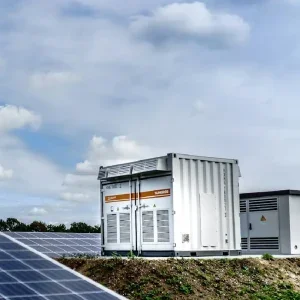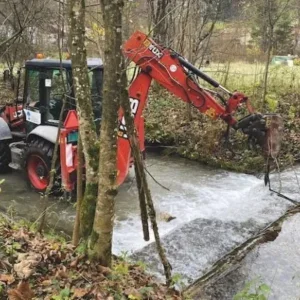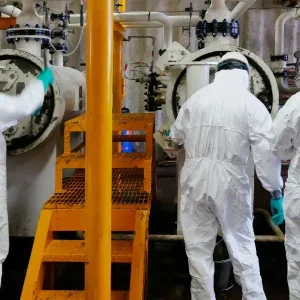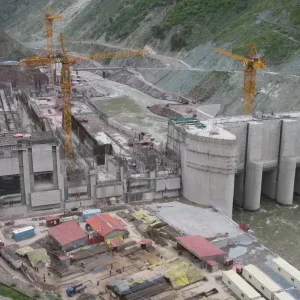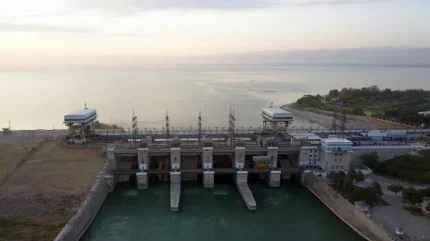
Across different corners of the world, GE Vernova’s recent efforts in Nigeria and Tajikistan underscore the vital role hydropower plays in meeting diverse nations’ energy needs, from improving capacity and sustainability in Nigeria to ensuring resilience and adaptability in Tajikistan.
The company’s Hydro Power business has recently successfully completed the commissioning of four 175MW Francis hydropower turbines and generators at Nigeria’s Zungeru project in Niger State. This development marks a significant milestone for the Zungeru project, located along the Kaduna River, and establishes it as Nigeria’s second-largest hydropower plant with a total capacity of 700MW.
The Zungeru project holds the promise of contributing to approximately 10% of Nigeria’s domestic electricity requirements, providing a substantial boost to the country’s energy needs with a focus on sustainability and reliability. Beyond electricity generation, the project will play a vital role in flood control and support for regional irrigation efforts.
The Engineering, Procurement, and Construction (EPC) company China National Electrical Equipment Corporation (CNEEC) selected GE Vernova to design, supply, supervise installation, and commission the four hydropower units. Furthermore, the Zungeru project has received essential investment support from the Export-Import Bank (Exim Bank) of China.
Brian Selby, Hydro Power Asia Leader at GE Vernova, noted the project’s significance, stating, “Nigeria is gifted with large rivers and natural falls that create opportunities for hydropower development. As the Government of Nigeria continues to pursue the expansion of generation capacity and extend the capability of its power grid, we are happy to help take advantage of the country’s water reserves to meet its increasing demand for sustainable, reliable, and efficient power. This project will have a wide-reaching impact on the country’s energy landscape.”
The International Hydropower Association (IHA) estimates Nigeria’s hydropower potential at over 14 GW, emphasizing the vital role of hydropower in Nigeria’s energy transition.
Over in Tajikistan, the company has successfully completed the upgrade of the first of six Kaplan turbine and generator units at the Qairokkum hydropower plant in the northwestern province of Sughd. The refurbishment project, undertaken in collaboration with Barki Tojik, marks a critical step towards enhancing the plant’s capacity and extending its operational life.
Built over 60 years ago, the Qairokkum hydropower plant has been the sole source of electricity for approximately 500,000 residents in the region, underscoring its vital role in the province’s power supply. The completion of the upgrade on the first unit, initially rated at 21MW, has now boosted its capacity to 29MW. Importantly, this enhancement sets the stage for all six units to undergo similar transformations, ultimately elevating the plant’s total capacity to a formidable 174MW.
GE Vernova leads the consortium responsible for this project, collaborating with Cobra, a division of Spain’s ACS Group. The scope of work encompasses the overhaul of the six turbines and generators, along with the necessary balance of plant upgrades and on-site supervision for the equipment supplied. It is anticipated that the comprehensive modernization of the Qairokkum hydropower plant will conclude by mid-2025.
“The work done in Tajikistan on making hydropower plants climate resilient is essential for our industry’s future and the global energy transition that we all support,” commented Bodo Mayer, Hydro Power EMEA Leader, GE Vernova. “We are extremely honored to contribute to this project and for the completion of the first unit’s rehabilitation. This remarkable boost in capacity sets the stage for even greater clean energy production as we prepare to bring five more units online.”
Tajikistan relies heavily on hydropower, with approximately 90% of its electricity generated from this renewable source. Given the nation’s dependence on hydropower, it becomes increasingly crucial to adapt existing infrastructure and develop new assets to meet future operational demands. The Qairokkum hydropower plant was strategically chosen to pilot this concept, serving as a testament to the ability of modernized facilities to not only generate more energy but also to address variations in water flow patterns within the region.
Indian contract
Another company that has recently been awarded a contract on a major hydropower facility is Bharat Heavy Electricals Limited (BHEL). The company said it will be supplying and commissioning the Electro-Mechanical (E&M) components of the largest hydropower project in India – the 2880MW Dibang Multipurpose Project in Arunachal Pradesh.
The contract for this 12×240 MW hydropower endeavour, located in Roing within the Lower Dibang Valley district of Arunachal Pradesh, has been awarded to BHEL by the National Hydroelectric Power Corporation (NHPC) following an international competitive bidding process
BHEL’s role under the contract involves several critical tasks, including the design, engineering, manufacturing, supply, installation, and commissioning of the electro-mechanical package. This package encompasses a wide range of components such as Turbines, Generators, Digital Governing Systems, Static Excitation Systems, Transformers, Bus Reactors, Gas Insulated Switchgear, Outdoor Pot Yard & Switchyard Equipment, as well as Electrical & Mechanical Balance of Plant (BoPs).
Major components necessary for the Dibang Multipurpose Project will be manufactured in BHEL’s facilities located in Bhopal, Bengaluru, Jhansi, and Rudrapur. Simultaneously, the execution and assembly work on-site will be managed by BHEL’s Power Sector – Eastern Region division, based in Kolkata.
This latest contract emphasizes BHEL’s long-standing partnership with NHPC, which spans more than four decades, beginning with the commissioning of the first project, Bairasul (3x60MW), in 1981. In addition to this achievement, BHEL is actively working on other ongoing projects, including the 850MW Ratle Hydropower Project in Jammu and Kashmir, handling limited E&M works, and the renovation and modernization of the 105MW Loktak Hydropower Project in Manipur.
Mini hydropower
A consortium comprising PT Andritz Hydro of Indonesia and Andritz Hydro Private Limited from India has signed a contract for the Merangin mini hydropower plant located in Jambi Province, Indonesia. This marks the consortium’s third collaboration with the Bukaka Group, following the successful completion of the Cikandang and Cikaengan-1 mini hydropower projects in 2021 and 2022.
The Merangin mini-hydropower plant, known as HPP Merangin, is designed to include a 3.199 MW horizontal Francis unit that will make use of the flow discharge from the 350 MW Kerinci Merangin HEPP, also under development by the Bukaka Group. Under the contract, Andritz is responsible for the supply of the turbine generator package and the control system. The execution of the Merangin mini hydropower plant will be carried out by specialists from Andritz in India and Indonesia.
First of its kind
RheEnergise, a UK clean-technology company specializing in long-duration energy storage solutions, has recently taken a significant step forward in its mission to revolutionize the energy storage landscape by signing a key manufacturing contract with Turkish engineering firm, Hydropower Engineering (HPE). This collaboration marks a pivotal moment for the development of RheEnergise’s HD Hydro® technology.
Under this partnership, HPE will undertake the manufacturing of RheEnergise’s inaugural 500kW HD Turbine™. This turbine is set to be a central component of RheEnergise’s long-duration energy storage demonstrator project, to be constructed near Plymouth, Devon, in the United Kingdom. The HD Turbine™, the first of its kind, will be delivered during the first quarter of 2024.
RheEnergise’s demonstrator project has garnered support from the UK Government through the Longer Duration Energy Storage (LoDES) Demonstration Programme, a vital component of the UK Government’s £1 billion Net Zero Innovation Portfolio (NZIP). The LoDES initiative is designed to expedite the commercialization of low-carbon technologies and systems.
What sets RheEnergise’s HD Hydro technology apart is its scalability, cost-effectiveness, and rapid deployment capabilities, said the company. Unlike conventional hydro-power systems, it employs an environmentally friendly fluid that is 2½ times denser than water, resulting in a substantial power boost. This innovative approach enables the deployment of HD Hydro on hills, removing the geographical constraints associated with traditional mountain-based hydropower systems and creating significant opportunities both in the UK and worldwide.
This development follows closely on the heels of RheEnergise’s recent agreement with British energy company Mercia Power Response, aimed at exploring the feasibility of deploying 100MW of HD Hydro into commercial operation by 2030. The strategic use of Mercia’s existing grid connections in the UK is expected to play a pivotal role in achieving this ambitious goal.
Stephen Crosher, Co-Founder and Chief Executive Officer of RheEnergise, expressed his enthusiasm for the collaboration with HPE, stating: “The placing of our order with HPE is an important milestone in our efforts to deliver our demonstrator project. The expansion of the long-duration energy sector, and using new technologies like our HD Hydro storage system, is vital as the UK and other countries are placing a greater reliance on wind and solar to meet their future energy needs and to achieve Net Zero.”
Caglar Cinar of Hydropower Engineering (HPE) added, “We are excited to be given the opportunity to work with RheEnergise in a new and innovative part of the international hydro sector. Given that their HD Hydro system can be deployed in many more locations than conventional forms of hydro, and quickly too, we see our turbine order from RheEnergise as a first of many. RheEnergsie’s HD Hydro offers a major business growth opportunity for HPE.”
Modernization project
Fortum has unveiled an ambitious plan to breathe new life into the Untra hydropower plant, a historic facility dating back to 1911. With an investment exceeding SEK 700 million (over €60 million) earmarked for the period 2023-2030, Fortum is setting its sights on revitalizing one of Sweden’s oldest hydropower plants.
This substantial commitment forms part of Fortum’s strategic endeavours aimed at delivering reliable, clean energy and catalyzing the decarbonization of industries in the Nordics.
Mikael Lemström, Executive Vice President of Hydro Generation at Fortum, emphasized the significance of this initiative, stating: “The construction of the Untra power plant had a significant impact on the first wave of electrification and today electricity is once more driving our transformation to Net Zero. Hydropower, known for its adaptability and extensive energy storage capabilities, continues to play an important role in our power infrastructure. As a result, investments of this nature are essential to ensure that hydropower maintains its position as a fundamental pillar of the Nordic’s carbon-neutral electricity production.”
The Untra Hydropower Plant, boasting a current output of 42MW, is set to undergo a comprehensive renovation. This includes the replacement of three turbine units and a substantial restructuring of the power plant, all aimed at enhancing Untra’s ability to provide flexibility to the power system and to deliver fossil-free electricity to Sweden. Thanks to the deployment of advanced turbine technology, annual electricity production is projected to increase from 270GWh to approximately 300GWh.
Untra, initially constructed with the goal of powering the entire city of Stockholm with electricity, played a pivotal role in electrifying the Swedish capital during the last century. Despite the rapidly growing demand for electricity in the capital, which exceeded Untra’s capacity in less than eight years, the power plant has retained its significance within the Swedish power system.
Made in America
In a vote of confidence for the future of US hydropower, Voith Hydro has made several recent investments in its flagship North American manufacturing facility in York, Pa. This new, state-of-the-art machinery and equipment includes a Pietro Carnaghi AP 120 TM Vertical Turning Lathe (VTL) and a PAMA Speedram 3000 Horizontal Boring and Milling Machine (HBM). The machine upgrades will result in increased production capacity, improved product quality, increased energy efficiency, greater tool life, reduced downtime, reduced waste, and enhanced worker safety. Voith Hydro is making these investments as part of its continued commitment to serving customers in North America and around the world. The retooling of Voith Hydro’s facility is occurring during a period of historic investments in Clean Energy resulting from the enactment of the Infrastructure Investment and Jobs Act and Inflation Reduction Act.
“Voith Hydro’s US manufacturing roots date back more than 145 years, and we are excited about this next chapter for our company,” Stanley Kocon, President and CEO of Voith Hydro North America. “We can and should make the products that power America right here in America, in places like York, Pennsylvania. The latest investments in our state-of-the-art manufacturing facility will be instrumental in building the next generation of hydropower turbines and hydro-pumped storage machines needed to meet our Nation’s ambitious climate and job-creation goals.”
These investments qualify as Advanced Energy Property under section 48C of the Internal Revenue Code, making them eligible for a potential tax credit to offset a portion of the costs of these investments in U.S. renewable energy equipment manufacturing. In addition to the 48C program, as a U.S.-based manufacturer, hydropower and pumped storage hydropower projects utilising Voith technology manufactured in the U.S. may also qualify for an additional 10% domestic content bonus, on top of other incentives and credits for building clean energy infrastructure.
Voith Hydro plans to place the new VTL and HBM into service by September 2024. The HBM adds new machining capabilities to an already diverse manufacturing footprint and the new VTL will be the second VTL deployed in York in the last five years. In 2019, Voith Hydro completed the installation of a VTL capable of machining turbines or runners weighing up to 200 tons.
This article first appeared in International Water Power magazine.


